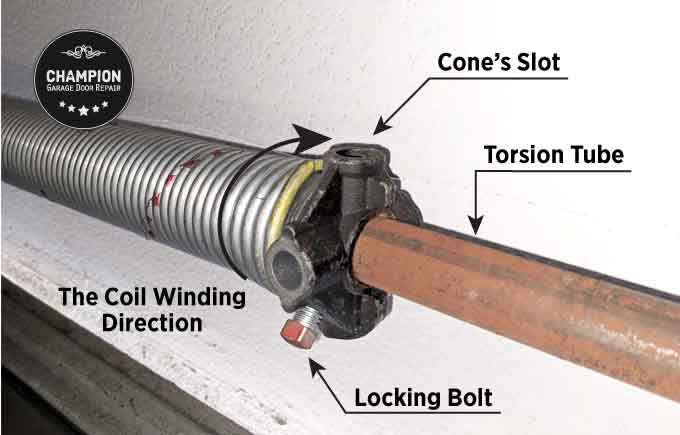There are multiple reasons why a garage door may be out of balance, including worn out springs, improper installation of the springs or torsion assembly, and springs that aren’t compatible with the garage door’s weight or setting. The right way to test the balance of your garage door is as follows.
- While the garage door is closed, disengage it from the automatic opener using the emergency release function.
- Manually lift the door up to your waist line. The door should stay in its position.
- Manually lift the door up to your shoulder line. The door should stay in its position.
If the door won’t stay in its position (falling down or pulling up) or if the door feels too jerky, it usually means that the garage door is not balanced, and that the springs may need to be recalibrated or replaced. A minor deviation from the standard however, doesn’t essentially means that the condition needs to be addressed.
If you continue to operate an imbalance garage door, the condition will eventually cause the door to come off its tracks, as well as will affect and damage the opener’s gears and sprockets, rollers, hinges, and may overload the torsion assembly’s bearings, resulting in premature failure of the overhead door’s mechanisms.
How to Balance A Garage Door
Before you start working on your garage door, keep in mind that the springs produce high torque output. Handling them without the proper tools or knowledge can result in a serious injury. Given the project’s risks, you may want to consult or hire a licensed garage door repair company, otherwise, start by following the steps below.
The tools you’ll need to balance a door with torsion springs:
- 2 winding bars.
- 7/16 inch (11mm) 12 points wrench.
- 2 vise grips (if the door has a single spring only).
- A ladder or steps tool.
First, make sure that there aren’t any objects in the way. If your garage door torsion assembly is a single spring assembly, use the vise grips to anchor the torsion tube in place so the cables won’t come off their pulleys.
1. Determine the Direction of the Turn
To add torque in standard settings, turn the spring clockwise or towards the garage ceiling. Turn it counterclockwise to subtract torque. Some settings however, have a reversed torsion assembly. In this case, turn the spring counterclockwise to add torque (towards the floor), and vice versa to subtract. You can recognize a reversed torsion assembly by the location of the springs and pulleys. The springs will be positioned inversely, meaning that when you’re facing the door, from inside the garage, the red conned spring will be on your right and the black conned spring on your left. The pulleys on the other hand, will be positioned on the outer side of the end bearing plates.

2. Release The Spring’s Locking Bolts
Have both winding bars within reach. Insert a winding bar to the torsion spring’s winding cone slot and hold it there. Using a 7/16-inch wrench, start releasing the winding cone locking bolts (there are 2 of them). Be cautious and hold the winding bar firm. Once the cone’s locking bolts no longer mount the spring to the axle, all the force will be transferred through the winding bar to your arm. Keep the wrench within reach. Make sure to follow the safety procedures that are discussed here.
3. Adjust the Spring
You can adjust the spring by rotating the winding bars in the desired direction. Rotate the first winding bar, then insert the second winding bar to the next available slot and rotate. Before you remove the first winding bar, make sure that the second one is properly positioned inside the slot. Do this in a consecutive order. Whether you’re adding torque or subtracting, do not rotate the spring more than one full turn (whole revolution) before testing the door balance.
4. Tighten the Locking Bolts
Make sure that the winding cone’s locking bolts are easily accessible and use the 7/16-inch wrench to mount the cone to the torsion tube. Do not over tighten the bolts. After initiating contact with the tube, turn the bolts one and a half full turns. Over tightening the bolts will damage the torsion tube.
5. Test the Garage Door Balance
Test the garage door balance and repeat the steps above if needed. If the door is pulling up, you’ll need to reduce the torque amount that the springs produce by unwinding them slightly, and vice versa.
Note that the spring’s torque must accommodate the garage door’s travel distance. A basic formula is: for each 1 foot, apply 1 full turn (you may go beyond that, but not less). For example, if your garage door is 7’ high, the springs must have at least 7 full turns. If your garage door is 8’ high, the springs must have at least 8 full turns and so on (with the exception of torsion springs that have an inner diameter of more than 2″). A torsion assembly with springs that aren’t sufficiently deflected will not keep the cables tight around the pulleys, resulting in the garage door coming off the tracks.
How to Balance A Garage Door with Side Springs (Extension Springs)
Extension spring are more common in 1 piece garage door settings and are easier to adjust. Bring the garage door to a fully open position. Make sure that the garage is secured in its place by placing a long enough 2×4 or a ladder at the end of it. Once the garage door is properly secured, remove the spring’s hook from the bottom chain and insert it in the desired chain link. If the garage door is heavy, insert the hook to a chain link that is closer to the jamb or wall in order to increase the spring stretch, and vice versa. In cases where the garage door cannot be balanced by adjusting the extension springs, the hinges and hardware will need to be adjusted as well.
As a rule of thumb, if your garage door is heavy, you’d want to increase the amount of torque that the springs produce. If the garage door is pulling up, you’d want to reduce the torque amount. Overall, a properly balanced garage door should feel relatively light enough to operate and travel smoothly up and down.
Keep reading:








